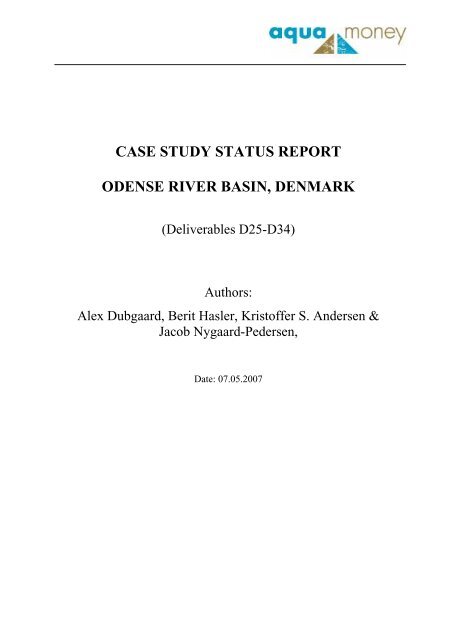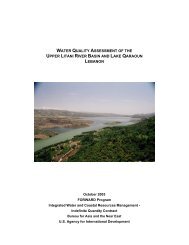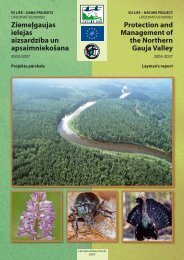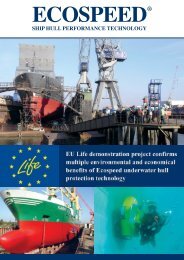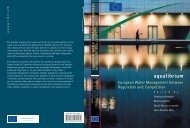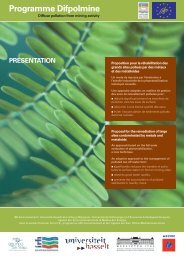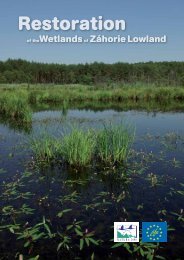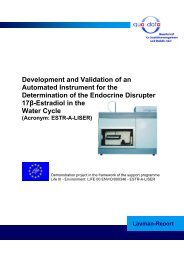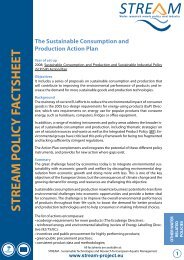case study status report odense river basin, denmark - wise-rtd.info
case study status report odense river basin, denmark - wise-rtd.info
case study status report odense river basin, denmark - wise-rtd.info
You also want an ePaper? Increase the reach of your titles
YUMPU automatically turns print PDFs into web optimized ePapers that Google loves.
CASE STUDY STATUS REPORTODENSE RIVER BASIN, DENMARK(Deliverables D25-D34)Authors:Alex Dubgaard, Berit Hasler, Kristoffer S. Andersen &Jacob Nygaard-Pedersen,Date: 07.05.2007
IntroductionThe Odense River Basin is a pilot area and test <strong>study</strong> for implementation of the WFD. As part ofthis test <strong>study</strong>, water bodies (surface water, wetlands, and groundwater) have been characterisedand the pollutant loading of groundwater and surface water assessed including the impact ofhuman activities on water <strong>status</strong>.The descriptions of area characteristics, environmental pressure and environmental objectives insection 1) and 2) in this <strong>report</strong> are based primarily on extracts from the pilot <strong>river</strong> <strong>study</strong> <strong>report</strong>:County of Funen (2003). Odense Pilot River. Provisional Article 5 Report pursuant to theWater Framework Directive. County of Funen.1) GENERAL CASE STUDY CHARACTERISTICS1.1. Location of the <strong>case</strong> <strong>study</strong> areaOdense River <strong>basin</strong> is located on the island of Funen, the second largest Danish island. The <strong>basin</strong>comprises an area of approx. 1 046 km2 with about 246 000 inhabitants. The town Odense is thelargest population centre in the <strong>basin</strong> area.3
Map of the Odense River Basin1.2. Geographical characteristicsClimateThe average monthly precipitation in Odense River Basin varies between approx. 40 mm (April)and 90 mm (December/January). A large part of the precipitation evaporates, especially insummer, and only a minor share reaches the watercourses. As a consequence, the variation inmonthly <strong>river</strong>ine runoff is considerably greater than the variation in precipitation. In summer the<strong>river</strong>ine runoff is therefore typically only around 20% of that in the winter months.In order to lead the water rapidly away from the typically clayey soils in wet periods, drainagehas been established on a considerable part of the farmland in Odense River Basin. Althoughsubject to some uncertainty, it is estimated that approx. 50% of the <strong>basin</strong> is drained. This has an(unknown) impact on the natural water cycle.The average air temperature in Funen is 8.2°C (1961—1990). The wind usually blows from thewest, and the power/energy with which the wind affects (stirs up) the water bodies varies.4
LithologyThe last Glacial Period, 11 500-100 000 years ago, is the prime creator the landscape known onthe Island of Funen today. Moraine planes covered by moraine clay are predominant. The claysoil types are slightly dominant and encompass approx. 51% of the <strong>basin</strong>, while the sandy soiltypes cover approx. 49%.TypologyOdense River Basin encompasses an area of approx. 1 046 km2 and includes approx. 1100 km ofopen watercourse and 2 600 lakes and ponds (>100 m2).Land usesLand use in the Odense River Basin is dominated by farmland accounting for 68% of the area.There are approx. 1,800 registered farms in Odense River Basin, of which approx. 900 arelivestock farms. Livestock production in the <strong>basin</strong> amounts to approx. 60,000 livestock units(LU), dominated by pigs (59%) and cattle (37%). The livestock density is 0.9 LU/ha.Urban areas account for approx. 16% of the area, woodland 10% and semi-natural areas for 6%,i.e. meadows, bogs/fens/swamp forests, dry grasslands, lakes and wetlands. Correspondingfigures for farmland, woodland and natural/semi-natural areas for Denmark as a whole are 62%,11% and just over 9%, respectively. Artificial drainage has been established on an estimated 55%of the cultivated land in Odense River Basin. The semi-natural areas including wetlands andwatercourses have undergone major physical changes and many of them have disappeared inrecent decades. Restoration of these areas is one of the measures to obtain good quality of thewater-bodies in the <strong>basin</strong>.The population of Odense River Basin numbers approx. 246 000. Approx. 90% of the populationin the <strong>basin</strong> discharge their wastewater to a municipal wastewater treatment plant. The remaining10% of the population live outside the towns in areas without access to sewerage.Biotic frameworkThe aquatic environment within the Odense River Basin comprises a significant number ofaquifers and surface water bodies in the categories of watercourses, lakes and fjords. These waterbodies are subject to varying pressures to their biotic and environmental state.The Odense Fjord holds some unique physical qualities which support a large range of species.The fjord constitutes an important habitat for birds and is as such subject to extensiveenvironmental legislation independent of the WFD.1.2. Water system characteristicsWithin the Odense River Basin there are 31 aquifers of which some are overlapping each other asthey are situated in different depths and some transgress the borders of the watershed and are thussituated in more than one <strong>river</strong> <strong>basin</strong> (County of Funen 2005c). The term aquifer relates to thesubterranean layers containing the groundwater which is utilised as drinking water and forseveral other consumption as well as production purposes. In order to live up to qualitative good5
The Odense River Basin also contains a significant number of lakes (approximately 2,620), all ofthem more than 100 m2. 1500 of these lakes occupy an area of less than 0.1 ha each, whereasonly 21 lakes occupy an area of more than 3 ha each (County of Funen 2005a).Odense fjord is by far the largest surface water body in the <strong>river</strong> <strong>basin</strong>. Odense fjord occupies anarea of 6,500 ha which may be divided in an inner and outer part with diverse physical attributes.Both sections of the fjord are in general shallow but the innermost part is especially so with anaverage registered depth of only 0.8 meters (County of Funen 2005d). The fjord resembles alarge estuary of the Odense River more than a typical fjord. The retention period of water is thusrather short at 17 days. Odense fjord may be categorised within the Odense River Basin as aterminal recipient of nearly all waterborne pollution which have not been remedied artificially ornaturally. The fjord is subject to a substantial load of a multitude of polluting substancesoriginating from both agricultural land in the entire <strong>river</strong> <strong>basin</strong> as well as several major industriesincluding shipping and shipyard activities as well as waste dumps and other minor activities.Sub-<strong>basin</strong>sThe <strong>river</strong> <strong>basin</strong> can be divided into 12 sub-<strong>basin</strong>s for the most important lakes. Each of the 11lakes presented are assigned to an individual sub-<strong>basin</strong> in which the specific lake constitutes asub-terminal water recipient. The remaining area within the Odense River Basin have beenascribed to the 12th sub-<strong>basin</strong> which has the Odense fjord as its first sub-terminal water recipient.The distribution of the 12 sub-<strong>basin</strong>s in the Odense River Basin is illustrated in figure 4 below.Figure 4: Distribution of sub-<strong>basin</strong>s within the Odense River Basin (County of Funen 2006).7
Several types of data can be compiled for each sub-<strong>basin</strong> as these represent the individual waterbodies which are targeted by reductions.Table 1. Soil- and agricultural area distribution of the sub-<strong>basin</strong>s within the Odense River BasinSub-<strong>basin</strong>sOdense FjordArreskov SøBrahe TrolleborgSlotssøBrændegård SøHigh land Soil, ha 27.826 637 369 305 19 60 33 207 686 194 98Low land Soil, ha 18.665 235 203 53 2 3 2 84 321 18 11Nitrate sensitive Soil, ha 18.200 91 71 0 0 5 0 23 0 0 0Total AgriculturalArea, ha 64.691 963 643 358 21 68 35 314 1.007 212 109There are 24 wastewater treatment plants in the Odense River Basin that each receiveswastewater from more than 30 persons. The great majority of the enterprises in the Odense RiverBasin lead their wastewater to municipal wastewater treatment plant.Nørre SøDallund SøFjellerup SøLange SøNørre Søby SøSøbo SøStore Øre Sø1.4. Characterisation of water useThe water cycle in Odense River Basin is affected by a number of human activities, for exampleabstraction of water for various purposes Table Table 4. Most of this abstraction is accounted forby waterworks (20 mm). The share of water abstraction accounted for by farms and marketgardens is relatively modest. Compared with water abstraction for these purposes in the sandyareas in western Denmark, the water requirements of the agricultural sector in Funen areconsiderably less. The abstraction carried out affects water flow in watercourses. The effect ismodest if assessed solely on the basis of the total annual runoff in watercourses, but water flow incertain watercourses can be significantly affected during the summer when water flow in thewatercourses is at its lowest level.Table 2. Water abstraction in Odense River BasinCategorymmPublic waterworks 19Institutional wells
of the amount of water that flows in the watercourses in dry summers. A considerable part of theabstracted drinking water is “returned” to the watercourses in the form of treated wastewater, butnot necessarily in the area from where it was abstracted. Within Odense River Basin largeamounts of groundwater are abstracted, in some catchments amounting to over 50% of themedian minimum water flow in the associated watercourses.Origin of water useFrom around the 13th Century some of the watercourses in the Odense River Basin weredammed for mill operation. This — together with the establishment of dams for meadowirrigation in the 19th Century — disrupted the continuity of the watercourses, thereby hinderingfish such as trout and eel from their natural migration between fresh water and sea water. Innewer times other obstructions have arisen too, for example culverts under roads.The appearance of the watercourses has also been changed through other forms of regulation.Many naturally meandering or sinuous watercourses have been straightened and the bedsexcavated, and in places the slope has been neutralized by the construction of falls. Theseactivities really started in the 18th Century and accelerated up through the 19th Century until thelast major regulation project in 1960, which encompassed a considerable part of the OdenseRiver (Riis et al., 1999). The aim of such regulation was to ensure improved drainage andthereby to increase the possibilities to use the adjoining land for agricultural production. At thesame time, rapid removal of the water was further accelerated in many places through intensivemaintenance in the form of clearance of all aquatic vegetation as well as vegetation along thebanks and borders of the watercourses and dredging of the bed substratum.List of protected areasInternational protected areas encompass EC Habitat Sites and EC Bird Protection Sites. WithinOdense River Basin there are seven international protected areas.EC Habitat Sites: Within the Odense River Basin seven EC Habitat Sites have beendesignated specifying the water dependent habitats and species that these sites weredesignated to protect.Basis for the selection of the EC Habitat Sites in Odense River Basin (habitats and species)* indicates priority habitat typesNo. 94 Odense Fjord:sandbanks which are slightly covered by sea water all the time, mudflatsand sandflats not covered by seawater at low tide, large shallow inlets and bays, atlanticsalt meadows, oligotrophic to mesotrophic standing waters with vegetation, watercourses of plain to montane levels, wet heaths with Erica.No. 97 The mires Urup Dam, Brabk Mose, Birkende Mose and Illemose; orchids, oligomesotrophicwaters with benthic vegetation, meadows on calcareous, peaty or clayeysilt-ladensoils, calcareous fens, alkaline fens, alluvial forests.No. 98 River Odense with River Hâgerup, River Sallinge and River Lindved; desmoulin’swhorl snail, common <strong>river</strong> mussel, brook lamprey, spined bach, watercourses of plain tomontane levels with the Ranunculionfluitantis and CallitrichoBatrachion vegetation,hydrophilous tall herb fringe communities of plains and of the montane to alpine levels.9
EC Habitat Sites: Within the Odense River Basin seven EC Habitat Sites have beendesignated specifying the water dependent habitats and species that these sites weredesignated to protect.No. 103 Storelung; degraded raised bogs still capable of natural regeneration, bog woodland.No. 104 Forests and lakes south of Brahetrolleborg; desmoulin’s whorl snail, geat crestednewt, natural eutrophic lakes, water courses of plain to montane levels with theRanunculionfluitantis and CallitrichoBatrachion vegetation, bog woodland.No. 105 Lake Arreskov; desmoulin’s whorl snail, natural eutrophic lakes, water courses ofplain to montane levels with the Ranunculionfluitantis and CallitrichoBatrachionvegetation, molinia meadows on calcareous, peaty or clayey-silt-laden soils (Molinioncaeruleae),hydrophilous tall herb fringe communities of plains and of the montane toalpine levels.No. 106 Lake Store Oreso, Lake Sorteso and Lake Igleso; natural eutrophic lakes,naturaldystrophic lakes and ponds, transition mires and quaking bogs, peat, fens.EC Bird Proctection Sites: Within Odense River Basin, three EC Bird Protection Sites havebeen designated specifying the bird species that the sites are designated to protect.EC Bird Protection Sites in the Odense River BasinNo. 74 Lake Brudegârd, Lake Norreso and forests around BrahetrolleborgCormorant Phalacrocorax carboGrey lag goose AnserCommon pochard AythyaferinaTufted duck AythyafuligulaNo. 75 Odense FjordArctic tern Sterna paradiseaSandwich tern Sterna sandvicensisMarsh harrier Circus aeruginosisAvocet Recurvirostra avosettaMute swan Cygnus olorWhooper swan Cygnus cygnusRed-breasted merganser Mergus serratorGoosander Mergus merganserCoot Fulica atraNo. 78 Lake ArreskovMarsh harrier Circus aeruginosisCommon tern Sterna hirundoGrey lag goose AnserCommon pochard Aythyaferina10
2) PRESSURE, IMPACT, AND RISK ANALYSIS WITHREGARDS TO THE WFD ENVIRONMENTAL OBJECTIVES2.1. Significant pressures impacting on water <strong>status</strong>(following IMPRESS and the DPSIR framework)‣ Point and diffuse source pressures (leading pollutants and sources of pollution)o Discharge from wastewater treatment plantso Discharges from stormwater outfalls in separate and combined sewerage systemso Wastewater from sparsely bilt-up areaso Separatet industrial dischargesThe water point-source dominated P load has since 1980s been reduced by a factor 6-7. The N-load, which is predominantly attributable to diffuse loading from farmland, has only beenreduced by around 1/3.2.2 – 2.4. Impacts on surface and groundwater bodies - water bodies at risk of not achievinga good <strong>status</strong>, and diagnosis of water quality and ecological issues (aquatic and relatedterrestrial ecosystems)Water coursesBased on the division in fauna classes currently applied to watercourses as a measure ofenvironmental quality and the interpretation of what ecological good <strong>status</strong> is equal to in thisindex, the watercourses within the Odense River Basin have been investigated and theirenvironmental <strong>status</strong> determined. The Odense River Basin contains approximately 931 kmnatural watercourses divided in three types where type 1 is the smallest and type 3 the largest.Furthermore 84 km of entirely artificial watercourse have been established in connection withhuman activities. The vast majority of watercourse kilometres investigated came out below theecological standard required by the WFD (County of Funen 2005b).The environmental state of the lakes within the Odense River Basin is in general below therequirements of good ecological <strong>status</strong> stated in the WFD. NERI estimates that nitrateconcentration can not be in excess of 1 mg/L if a lake is to hold good ecological <strong>status</strong>(Søndergård et al. 2003). Furthermore phosphorous content of a lake should not exceed 0.05mg/L in shallow lakes and 0.025 mg/L in deep lakes if good ecological state is to persevere. Dueto extensive diffuse nitrate and phosphorus pollution mainly originating from agriculture andpoint source pollution originating from sewage most lakes experience a nitrate and phosphorouscontent significantly larger than what is specified as a requirement to uphold good ecological<strong>status</strong>. Although sewage is less responsible for the pollution than was the <strong>case</strong> before the firstaction plans were contemplated it is still a significant source of pollution as rural waste treatmenthas not been updated at the same speed as seen in urban areas. Phosphorous pollution influence11
the ecological state of a lake much more than is the <strong>case</strong> for most other water body types due tothe long retention periods of water present in lakes (County of Funen 2005a).Ten lakes have been subjected to a full analysis by the County of Funen in relation to the pilotproject, and given specific reduction objectives with regard to phosphorous- and nitrateemissions and -pollution. Although 10 lakes seem to be a low number it should be noticed thatthat these lakes equals a share of more than 50 % of collective lake surface area of the OdenseRiver Basin. In table 1 the lakes are presented along with their reduction objectives.Table 1: N- and P-reduction targets of major lakes within the Odense River BasinP-Reductionrequirements,kgN-Reductionrequirements,tonsArreskov Sø 152 0,0Brahe Trolleborg Slotssø 224 13,4Brændegård Sø 174 4,1Nørre Sø 24 0,6Dallund Sø 13 0,3Fjellerup Sø 10 0,4Lange Sø 58 4,0Nørre Søby Sø 144 3,0Søbo Sø 25 0,2Store Øre Sø 18 0,1A description of the objectives for the water bodies, types and reference conditions is depicted intable.12
Table 12 Overview of water bodies in the main course of the River Odense and Ryds Streamcatchment indicating typology (provisional system), heavy modification (HM, provisionaldesignation), reference conditions assessed from the macro invertebrates (fauna class, FC;provisional classification), current <strong>status</strong> assessed from the macro invertebrates (FC), ecological<strong>status</strong> assessed from the macro invertebrates and physical conditions (provisional, based on FCand modified Aarhus Index), current objective pursuant to the Regional Plan currently in force,future objective (provisional assessment) pursuant to the Water Framework Directive (WFD),and expected compliance with the objective (provisional assessment)in 2015. The WFDobjectives are abbreviated H: High; G: Good; M: Moderate; P: Poor and B: Bad.Indicates that the reach is encompassed by the Habitats Directive, such that special requirementscan be expected concerning safe guarding certain species or habitats. ** Indicates that theobjective for the watercourse was first set during an inspection in spring 2003. Expectedcompliance with the objective has been assessed with respect to both improved water quality inconnection with planned wastewater treatment in sparsely built-up areas (WWT) and improvedphysical conditions (IPC). Expected compliance is indicated by +, and non-compliance by —.Reaching the objectives requires the use of at least one but most likely several environmentalmeasures which differ in costs and effectiveness towards reduction of nitrate- and phosphorous13
pollution. With regards to the twelve targeted lakes the analysis at hand provides different choiceof measures and in many <strong>case</strong>s choice of application level of the individual measures. For theremaining lakes the measure is decided prior to the analysis and the level of application remainsfixed.Despite prior environmental legislation recent investigations in relation to the article 5 analysishave shown that the ecological <strong>status</strong> is significantly below good for the fjord. Setting thereduction target for the fjord is a tricky business as its importance as a unique habitat warrants anecological <strong>status</strong> even above good whereas its commercial importance may prove to render costsdisproportionate. In recognition of these issues the target is set at good ecological state for thefjord. Based on the analyses undertaken by the County of Funen annual reduction which wouldlead to the establishment of good ecological <strong>status</strong> has been estimated to be in the area of 880tons of Nitrate and 21,5 tons of phosphorus (County of Funen 2005d). As was the <strong>case</strong> with thelakes, these reduction targets are uncertain but likely estimates based on the available knowledgewhich is why they must be applied cautiously in an analysis such as this and steps should betaken to take any potential discrepancy into account. The target reductions are furthermore basedon an approach which takes into account any WFD independent measure which has been appliedor is to be applied that would lead to a reduction in nitrate and phosphorus pollution. These as ofyet unregistered reductions have thus been estimated and deducted from the target reductionestimated above.The current phosphorus and nitrate pressure experienced by the Odense fjord originates mainlyfrom agriculture providing 68 % and 43 % of the nitrate and phosphorus load respectively. Pointsources such as households and industries provide 14 % of the nitrate load and 34 % of thephosphorous load whereas the remaining percentages are ascribed to reference loading. Figure 2illustrates the origin of nutrient load to the fjord.Origin of nutrient load8060%40200NonpointsourcesPointsourcesReference loadingNitrate 68 14 18Phosphor 43 34 2314
Figure 2: The origin of N- and P-loading to the Odense FjordFor most of the point source pollution removal projects have been planed prior to the WFD andfigures thus under the projects defined as baseline measures.2.5. General trends and future pressuresThe water quality is improving, but it still is not good in a majority of the surface water bodies inthe <strong>basin</strong>. Most lakes, water courses and other surface water bodies do not fulfil the objectives inWFD.3) ERC ANALYSIS AND METHODOLOGICAL ISSUES3.1. List of main water-related goods and services provided in the <strong>basin</strong>The non market use values related to the water bodies in the <strong>river</strong> <strong>basin</strong> comprise recreation, bothbathing waters and fishing waters. The following maps and tables indicate the localisation ofthese sites.Recreational fisheriesThe map shows localities suitable for recreational fisheries at the island of Funen.Table 1 describes the type of fishing at these localities.15
Table 1 Localisation and type of fisheryName Town Type of fisheriesAgernæs - Flyvesandet - Egebjerggård Otterup CoastalAgernæs saltvandssøer Ebberup Lake, Put & takeAvernakø & Lyø Faaborg CoastalBøgebjerg Strand Dalby CoastalBørge's Put and Take Aarup Lake, Put & takeBåring Strand Asperup CoastalEnebærodde Otterup CoastalFyns Fiskevand Odense SØ Put & takeFyns Hoved Martofte CoastalFønsskovNørre Aaby CoastalFaaborg & Horne Land Faaborg CoastalGabet Mesinge CoastalGals klint Middelfart CoastalGl. Slot v. Hindsgavl Slot Middelfart CoastalIbjergvejens Fiskevand Årslev Put & takeKertemindeKerteminde CoastalLangelands Lystfiskersø, Tryggelev Humble Put & takeLindegårdens Fiskesø Otterup Lake, Put & takeMiddelfart Havn Middelfart CoastalMosegårdens Put & Take Søndersø Bog, marsh, Lake, Put & takeOdense Å - opstrøms Bellinge Bro Odense C Water ways, streamsSpodsbjerg Lystfiskersø Tranekær Put & takeStavre HovedKerteminde CoastalStavrs Hoved ved Røjle Skov Middelfart CoastalStrib Fyr Middelfart CoastalStrib Nordstrand Middelfart CoastalSvinø, sydvestsiden Middelfart CoastalTybrind Vig Ejby CoastalWedellsborg Hoved Ejby CoastalAalsbogaard Lystfiskersø Aarup Lake, Put & take16
Bathing resorts/beaches (58 results)The map indicates the bathing resorts at the island of Funen.www.visit<strong>denmark</strong>.dkTable 2 describes the bathing resorts, the localisation and the type of resort, incl. whether the beach has ablue flag.Name Town Blue flagAborg Strand Assens YesAssens Næs Assens YesAssens/Mariendal Assens YesBogense Strand Bogense NoBrydegård Strand Haarby YesBukkemose Strand Humble NoBækskilde strand,SvendborgNoDrejøBøgebjerg Strand Dalby NoBøjden Strand Faaborg NoBøsøre VormarkStrandHesselagerNoBåring Strandv/MolevejAsperupYesChristiansmindesvendborgYesStrandDageløkke Strand Tranekær NoDrejet, Spodsbjerg Rudkøbing YesDrejø Strand Svendborg NoDyreborg Strand -Knold, DrejetFaaborgNo17
Elsehoved Strand Vejstrup NoErikshale Marstal YesFlyvesandet Otterup NoFuglsang Otterup NoFyns Badestrand Nyborg NoFynshoved Strand Martofte NoFøns Strand v/FønsStrandvejNørre AabyYesHasmark Otterup NoHelnæs Made Ebberup YesHelnæs Strand Ebberup YesHesselbjerg Strand(Østersøbadet)HumbleYesHesseløje Strand Faaborg NoHorne Sommerland Faaborg NoHou Nordstrand Tranekær NoKertemindeNordstrandKertemindeYesKerteminde Sydstrand KertemindeYesKlinten Strand vedferiehotel Klinten i FaaborgYesFaaborgKlintholm VormarkHesselagerHesselagerNoLehnskov Strand Svendborg NoMiddelfart Marina Middelfart YesNab Strand Faaborg NoRevsøre Strand Hesselager NoRistinge Strand Humble YesSaltofte Strand Assens YesSandager Næs Assens YesSinebjerg Strand Faaborg NoSkårupøre Strand Skårup Fyn NoSkåstrup Strand Bogense NoSlotshaven Strand v.Valdemars SlotSvendborgYesSmørmosen Svendborg YesSnøde/HesselbjergStrandTranekærNoStoense UdflytterStrandTranekærNoStrandholmen vedFaldsled byMillingeNoStrib Nordstrand Middelfart YesSønder Aaby Strand EjbyNoThurø Rev Svendborg NoTørresø Otterup NoVarbjerg Strand Ejby No18
Vejlby Fed Middelfart YesVesterstrand,ÆrøskøbingÆrøskøbing NoÅbyskov Strand Skårup Fyn NoÅ-Strand Ebberup YesNon use valuesThe non use values can be described from the protected areas description and from thedescription of biotic content. This is currently elaborated upon in the <strong>case</strong> <strong>study</strong>.3.2. List possible benefits and cost from water services [see Annex]These will be described using the former <strong>info</strong>rmation in the blue print of the <strong>case</strong> <strong>study</strong>.3.3. Proposed methods and tools for the valuation of ERC:The cost estimationsDetailed analyses of impact of measurers and the related costs have been conducted for theOdense River Basin. The conclusion was that a reduction in N-loss of 1.200 tons N to OdenseFjord was needed to reach the likely target in The Water Framework DirectiveThe analysis of the costs described in Jacobsen et al., 2004 shows that the costs using a range ofpredefined measures including more catch crops, wetlands, afforestation, organic farming andreduction in livestock lead to a yearly direct cost of 8.6 million € (8 € per kg N reduced loss).Choosing the most cost effective measures the costs were reduced to around half of this amount.In order to achieve this, the area with wetlands was increased from 4,000 to 5,400 ha in modelruns, which is 8 percent of the total agricultural area. Furthermore, reductions in livestock andafforestation were replaced by higher utilization of N in animal manure.When large decreases in nitrogen losses is the aim, it is very important to analyze the effect ofmeasures in conjunction with the effect of other measures as a partial analysis might overestimatethe effect of some measures. The analyses showed that measures, such as wetlands, aimed atreducing both nitrogen and phosphors losses, can be very cost efficient. The future analyses willlook more closely at the realistic level of given measures, the costs, and the implication foranimal production in order to achieve the targets in the WRD. Also comparisons betweenmeasures aimed at reducing nitrogen or phosphorus loss might be possible, but this requiresmodels aimed at describing the P-transport from land to the water bodies and they are to bedeveloped further.With respect to lakes it is estimated that only one of 12 large lakes might fulfil the WRDrequirement in 2015. Good ecological conditions are set at 0.025–0.05 mg P/l depending on thedepth of the lake. The quality of the lakes can only improve if nutrient losses from agriculturaland households are reduced. Also for streams there is a need for a further reduction in mainly N-losses as a majority of the streams are not expected to reach the required standard in 2015. Theconclusion is that a range of measures will be required in order to achieve the targets in the WRDset for Odense Fjord, the lakes and the streams in the Pilot River Basin. Costs analyses willtherefore be broader than the cost analysis included in the Pilot River Basin analyses.19
A) Inductive methods for valuing water goods/servicesStated preferences methodsThe <strong>case</strong> <strong>study</strong> comprises a primary valuation survey based on the choice experiment method.This method is suitable for valuing a multi-attributed environmental project like the protection ofthe Odense River Basin. Value estimates will be obtained for management benefits at differentgeographical scales, i.e. the total <strong>river</strong> <strong>basin</strong> and the water bodies in the <strong>river</strong> <strong>basin</strong> systems. Thevaluation will consider the major environmental damage categories in the <strong>river</strong> <strong>basin</strong>, i.e.groundwater contamination and chemical <strong>status</strong> related to drinking water quality, physical andchemical pressures and pollutant loading of watercourses, the Odense River, the lakes wetlandsand coastal waters, and the effects of these damages on the ecological <strong>status</strong> of these waterbodies. These effects comprise the quality of the living conditions for fauna and flora, as well asindicators like sight depth, swimming and bathing quality and fishing water quality. Asmentioned there are available data for all these damage types and the related effects.Benefit transfersThe Danish <strong>case</strong>-<strong>study</strong> area will serve as a primary focus area for the benefit-transfer evaluationand calibration exercise in this project. Cost and benefit measures obtained in the primary <strong>study</strong>and the area specific analyses described above will serve as a benchmark for evaluating thetransfer of benefit and cost estimates from other studies. This allows for an evaluation andcalibration of benefit transfer methods within the WFD-activities. This is needed to secure thatthe project will provide values that can be legitimately used for water pricing and CBAs, i.e. a setof "standard" values which are generally and broadly supported by the different stakeholdersinvolved.The benefit-transfer exercise will be undertaken in two version: One using national studies forbenefit transfer, and one using international studies all together. Furthermore, the benefit transferwill evaluate the results of using primarily other wetland-studies as <strong>info</strong>rmation basis, and ofusing a broader set of studies, transferring estimates on a ‘function’ or ‘attribute’-level, like e.g.the value of biodiversity and recreational aspects, the cost of land restoration and tendingactivitiesetc. etc.The number of relevant studies internationally is very large and the relevant studies to includehere should be critically selected relying on the specific knowledge among the partners of thisproject. During the last couple of years there has been an upsurge in valuation studies andenvironmental cost-benefit analyses in Denmark – sponsored to a large extent by the DanishEnvironmental Protection Agency and the Forest and Nature Protection Agency. In the followingwe will briefly describe a number of recent studies – apart from those mentioned above – hasbeen (or will be) concluded in the past (or coming) few months:The investigations will draw on the experience from a recent Danish cost-benefit analysis of amajor <strong>river</strong> <strong>basin</strong> restoration undertaking – the Skjern River project (see Dubgaard et al.). Theemphasis in this project was on biodiversity restoration and the re-creation of the ability ofnatural wetlands to filter nutrients and other particles in the <strong>river</strong> water. A Danish groundwatervaluation <strong>study</strong>, valuing the effects on groundwater protection on drinking water quality andsurface water quality (flora and fauna in watercourses and lakes) was conducted in 2004, and theresults are available for benefit transfer test in the <strong>case</strong> <strong>study</strong> (Hasler et al, 2005). A Danishvaluation <strong>study</strong> of wetland (<strong>river</strong> <strong>basin</strong>) restoration projects with focus on biodiversity,recreational values, aesthetics etc. will be concluded June 2005. A recent <strong>study</strong> on the value of20
iodiversity on the Danish moors provide further support for transfer (Boiesen et al. 2005), andin 2005 a number of new studies will be undertaken. This include a <strong>study</strong> on the value of wildlifein different habitats – one being wetlands, a valuation <strong>study</strong> of a specific wetland restorationproject and a larger valuation <strong>study</strong> of the new national parks – some of these have significantimpact on watershed management and values. Thus, a number of up-to date local studies will beavailable for testing the use of benefit- (cost-) -transfer within the local (national) setting and anumber of these will be on quite similar <strong>case</strong>s, whereas others will have a more general ordifferent focus.3.4. Available studies/<strong>info</strong>rmation on cost/benefits and expected problems of <strong>info</strong>rmation- Odense Pilot River Basin Provisional Article 5 <strong>report</strong> (http://<strong>odense</strong>prbuk.fynsamt.dk/wm134077).- Work prior to the Aquatic Action Plan III (2004) (www.vmp3.dk), cost-effectiveness ofmeasures and environmental effects (in Danish).- Choice experiment <strong>study</strong> will be carried out, start in 2006. Choice experiment ongroundwater has been carried out for Denmark in 2004/2005.- Ministry of Environment (Forest and Nature protection agency, Environmental ProtectionAgency, The County of Funen).21
REFERENCESBarbier, E.B., M. Acreman, D. Knowler, 1997. Economic Valuation of Wetlands, a guide forpolicy makers and Planners. RAMSAR Convention Bureau, Gland, Switzerland.Freeman, A.M. III, 2003. The measurement of environmental and resource values. Theory andmethods. Resources for the Future, Washington, DC.NRC, National Research Council, 1997. Valuing groundwater. Economic concepts andapproaches. National Academic Press, Washington, DC.NRC, National Research Council, 2004. Valuing Ecosystem Services. Toward betterenvironmental decision-making, Washington, DC.County of Funen (2003). Odense Pilot River. Provisional Article 5 Report pursuant to the WaterFramework Directive. Fyn County.http://<strong>odense</strong>prbuk.fyns-amt.dk/wm134077Rogers, P., R. de Silva, and R. Bhatia. 2002. Water is an economic good. How to use prices topromote equity, efficiency, and sustainability. Water Policy (4): 1-17.WATECO, 2002. Economics and the Environment. The implementation challenge of the WaterFramework Directive. A Guidance Document. Guidance document N.1, CommonImplementation Strategy for the Implementation of the Water Framework Directive, EuropeanCommission 2002. http://forum.europa.eu.int/Public/irc/env/wfd/library?l=/framework_directive/.P. Wiberg-Larsen, K. P. Brodersen, S. Birkholm, P. N. Grøn, J. Sk<strong>river</strong> (2000)Species richness and assemblage structure of Trichoptera in Danish streamsFreshwater Biology 43 (4), 633–647.Young, R., 2005. Determining the economic value of water: concepts and methods. Resourcesfor the Future, Washington, DC.22


